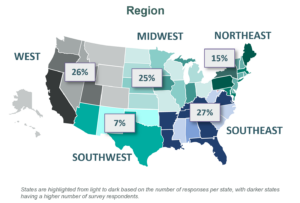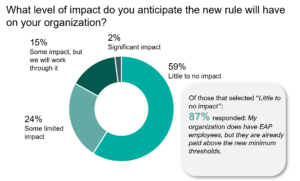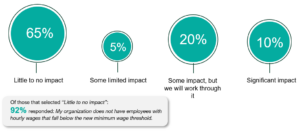
Over the past several years, ophthalmology practices nationwide have faced increasing operating expenses and higher employee salaries. VMG Health, formerly BSM Consulting, conducted a Member Hot Topics Survey in the late summer of 2024 to better understand recent legislation regarding overtime rules and minimum wages. We aimed to understand the potential impact of compensation-related legislation on ophthalmology practices nationwide. VMG Health received 154 responses from our Ophthalmology Connection (BSM Connection®) members, who gave us insights into how the new overtime rules and minimum wage increases affect their operations and business plans.
Ophthalmology Connection (BSM Connection®) is the leading online practice management and training resource designed specifically for eyecare clinics, including private practices, enterprise accounts, and teaching institutions. When you become a member, your entire team—administrators, managers, front desk staff, business office personnel, and clinical staff—gain 24/7 access to our convenient, easy-to-use, online library.
Participant Demographics
Our survey participants, representing various eyecare clinics across the United States, provided a comprehensive view of the industry. The Southeast region accounted for the highest percentage of respondents at 27%, followed closely by the West at 26% and the Midwest at 25%. The Northeast contributed 15%, while the Southwest comprised 7% of the responses.
Participant Demographics Overview

We gathered insights on provider composition and service models across ophthalmology practices, revealing a mix of practice sizes and specialties. Additionally, most respondents reported no affiliation with private equity groups, though a minority were affiliated with management service organizations.
Understanding the Overtime Rule
Our initial focus is on the Overtime Rule, which expands overtime protections for salaried workers under the Fair Labor Standards Act (FLSA). The FLSA stipulates that “most employees in the United States must be paid at least the federal minimum wage for all hours worked and overtime pay at not less than time and one-half the regular rate of pay for all hours worked over 40 hours in a workweek.”
According to the Department of Labor’s (DOL) Salary Basis Fact Sheet #17G, for an employee to be exempt from overtime pay, they must meet specific criteria. These exemptions, commonly referred to as “white-collar” or executive, administrative, and professional (EAP) exemptions, require that employees generally fulfill specific tests related to their job duties and be compensated on a salary basis of at least $684 per week. Job titles alone do not determine exempt status; an employee’s specific job duties and salary must align with the DOL’s regulations.
Starting July 1, 2024, salaried workers earning less than $844 per week (approximately $43,888 annually) became eligible for overtime pay. This threshold will increase to $1,128 weekly (about $58,656 annually) on January 1, 2025.
While many employees within ophthalmology practices are hourly, non-exempt workers who qualify for overtime, this ruling could significantly impact other positions that may be classified as exempt from overtime pay. These positions include executive, administrative, professional, computer, and outside sales employees.
Overtime Rule Familiarity
We found varying levels of awareness regarding changes to the overtime rule. Twenty-three percent of respondents acknowledged having heard about the changes but had yet to take action. When we asked about the potential impact of the new overtime rule, more than half of our respondents believed it would have little to no effect on their operational practices. When answering questions regarding the new overtime rule’s impact, most of those respondents noted, “My organization does have EAP employees, but they are already compensated above the minimum thresholds.”
Anticipated Overtime Rule Impact

When assessing the overall employee impact within the ophthalmology sector, 69% of respondents estimated that less than 8% of their total employee base would be affected by this updated regulation.
Mitigation of the Overtime Rule Impact
Practices affected by the recent changes to the overtime rule are actively seeking strategies to reduce its impact. They shared the following approaches:
- Adjusting Work Schedules: To ensure compliance, practices are modifying work schedules to prevent non-exempt employees from exceeding 40 hours per week. It is crucial to understand that an employee can be salaried—receiving a consistent weekly salary—and still be classified as non-exempt, thus qualifying for overtime pay. If a practice employs individuals in this category, their salary may remain unchanged; however, any hours worked beyond 40 in a week will qualify for overtime compensation.
- Reclassifying Employee Status: Due to the new salary thresholds, employees who no longer meet the criteria for exempt status may need to be transitioned to non-exempt or hourly status, requiring practices to pay overtime for any hours worked above 40 in a week.
- Increasing Salaries Above Thresholds: Another possible strategy is to raise employee salaries above the new thresholds. By doing so, practices can ensure affected employees meet both the salary requirements and the exemptions for EAP classifications, thereby avoiding the need to pay overtime.
Minimum Wage Increases
Throughout 2024, many practices faced increased wage changes thanks to minimum wage increases that will continue over the next few years. Various states and cities have implemented new minimum wage rates.
For instance, California has established a minimum wage of $16.00 per hour for all employers, effective January 1, 2024. Additionally, specific sectors will see even higher rates: fast-food restaurant employers in California must pay a minimum wage of $20.00 per hour starting April 1, 2024. Employees in healthcare facilities with fewer than 10,000 employees will earn $21.00 per hour beginning June 1, 2024, with scheduled increases continuing through 2028.
Minimum Wage Impact
When reviewing the potential impact of these minimum wage increases on their practices, many respondents indicated that the changes would have little to no effect. Among those who felt the impact would be minimal, 92% stated, “My organization does not have employees with hourly wages that fall below the new minimum wage threshold.”
Anticipated Minimum Wage Impact

Mitigation of Minimum Wage Increase
As reimbursements decline and operational costs rise, ophthalmic practices actively seek ways to enhance business operations while managing fewer resources. We closed the survey by asking our members how they address the challenges posed by increases in minimum wage and the subsequent impact on their practices. The responses highlighted several strategies:
- Enhancing Productivity and Efficiency: Practices focus on improving productivity and operational efficiency to offset rising costs. This strategy may involve streamlining processes, adopting new technologies, or optimizing staff workflows.
- Potential Headcount Reduction: Some practices consider reducing their workforce to manage expenses more effectively. This approach, while challenging, may be necessary to maintain financial stability.
- Re-Evaluating Expenses: Organizations thoroughly review their expenses to identify potential cost savings. This process includes scrutinizing operational costs, possibly changing vendors, comparing year-over-year cost increases, and minimizing expenses without compromising patient care.
- Updating Wage Scales: Practices are reviewing and updating their wage scales to remain competitive and compliant with local wage increases.
In conclusion, as ophthalmic practices navigate the complexities of rising minimum wages and changing reimbursement structures, proactive strategies are essential for maintaining operational stability. Together, as an ophthalmic community, we can navigate these changes and continue supporting what matters most to our industry.
Thanks to our Ophthalmology Connection (BSM Connection®) members for your engagement and insights into these critical topics. Members can download the full report on Connection. Log in using your credentials and view the report now.
Sources
U.S. Department of Labor. (n.d.). Fact Sheet #17G: Salary basis requirement and the Part 541 exemptions under the Fair Labor Standards Act (FLSA). U.S. Department of Labor. https://www.dol.gov/agencies/whd/fact-sheets/17g-flsa-salary
Business Management Daily. (n.d.). Overtime labor law: 6 compliance tips to avoid overtime lawsuits, wage-and-hour labor audits, and FLSA exemption mistakes. https://training.businessmanagementdaily.com/3002/overtime-labor-law/?src=bmd-freeproducts-el-overtimelaborlaw
Looman, J. (2024, April 23). What the new overtime rule means for workers. U.S. Department of Labor Blog. https://blog.dol.gov/2024/04/23/what-the-new-overtime-rule-means-for-workers
New California law pushes health care workers’ minimum wage to $25 per hour. (2023, October 16). Human Resources Director. https://tinyurl.com/4b47p8ez





